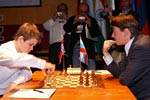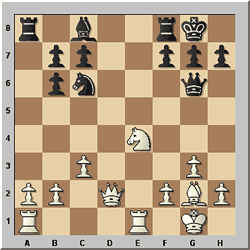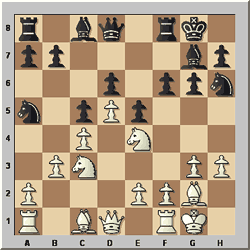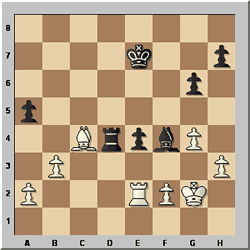
Round one
Round 1: Saturday, February 17th |
| Vassily Ivanchuk |
½-½ |
Peter Leko |
Veselin Topalov |
½-½ |
Vishy Anand |
Peter Svidler |
½-½ |
Levon Aronian |
Magnus Carlsen |
1-0 |
Alex. Morozevich |
|
|
Round 2: Sunday, February 18th |
Peter Leko |
|
Alex. Morozevich |
Levon Aronian |
|
Magnus Carlsen |
Vishy Anand |
|
Peter Svidler |
Vassily Ivanchuk |
|
Veselin Topalov |
Games – Report |
|
We bring you the cross table at thes early phase because it shows something
truly unique: a 16-year-old leading in a Super-GM tournament!
Commentary by GM Mihail Marin
The following express commentary was provided by Romanian GM Mihail Marin,
who is the author of a number of very popular ChessBase training CDs and articles
for ChessBase Magazine. GM Marin will study the games of the Morelia/Linares
tournament in greater detail and provide the full results of his analysis in
the next issue of ChessBase
Magazine.
Svidler,P (2728) - Aronian,L (2744) [C89]
XXIV SuperGM Morelia/Linares MEX/ESP (1), 17.02.2007 [Mihail Marin]
1.e4 e5 2.Nf3 Nc6 3.Bb5 a6 4.Ba4 Nf6 5.0-0 Be7 6.Re1 b5 7.Bb3 0-0 8.c3 A
specialist of the Marshall Attack himself, Svidler decides to take the bull
by the horns. 8...d5 9.exd5 Nxd5 10.Nxe5 Nxe5 11.Rxe5 c6 12.d4 Bd6 13.Re1
Qh4 14.g3 Qh3 15.Re4 g5 16.Qf1 Qh5 17.Nd2 Bf5 18.f3 Nf6 19.Qg2 Qg6 20.Re3 Rae8
21.Ne4 Nxe4 22.g4 Ng3 23.hxg3
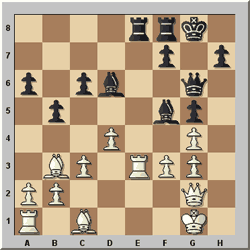
23...Bd3N. Aronian decides to deviate from his recent game against
Anand, possibly fearing his opponent's speciffic preparation. After 23...Bb1
24.Qe2 Rxe3 25.Qxe3 h6 26.Qe1 Bc2 27.Bxc2 Qxc2 28.Qe4 Qd1+ 29.Kg2 Kg7 30.Qe3
Bxg3 31.Kxg3 Re8 32.Qxe8 a draw was agreed in Anand-Aronian, Wijk aan Zee 2007.
In spite of his huge material disadvantage, Black will give perpetual. 24.Bd2
Rxe3 25.Bxe3 Re8 26.Re1 c5 27.dxc5 Bxc5 28.Qd2 Bxe3+ 29.Rxe3. White has
managed to emerge out of the opening with what might seem like a sound extra-pawn.
However, some subtle tactical nuances will allow Black achieve a draw more or
less by force. 29...Qb6 30.Kf2 Rd8 This is it. White has no way to free
himself from Black's domination. 31.Qe1 Re8 32.Qd2 Rd8 33.Bc2 Bg6 34.Qe2
Re8 35.Bxg6 hxg6 36.Qd2 Rd8 37.Qe2 Re8 38.Qd2 Rd8 1/2-1/2. [Click
to replay]
Topalov,V (2783) - Anand,V (2779) [E15]
XXIV SuperGM Morelia/Linares MEX/ESP (1), 17.02.2007 [Mihail Marin]
1.d4 Nf6 2.c4 e6 3.Nf3 b6 4.g3 Ba6 5.b3 Bb4+ 6.Bd2 Be7 7.Bg2 c6 8.Bc3 d5
9.Ne5 Nfd7 10.Nxd7 Nxd7 11.Nd2 For Topalov, this variation has been a fertile
territory for research and innovating along the past years. 11...0-0 12.0-0
Nf6 13.e4 dxe4 14.Nxe4 b5 15.Qe2N. This new move leads to an interesting
position. Previously, 15.Nc5 had been played, when after 15...Bxc5 16.dxc5 bxc4
17.Qe2 Nd5 18.Be5 Qg5 19.Bd6 Rfd8 20.bxc4 White was in complete control in the
game L'Ami-Iordachescu, Vlissingen 2006. 17...Qd3 looks like an improvement
for Black. 15...bxc4 16.Rfd1 Nd5 17.Be1 Nb6.
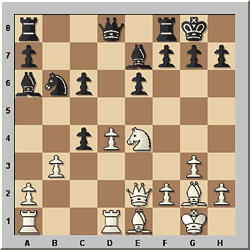
A paradoxical situation: For White, it will not be easy to win the pawn back
without making certain strategic concessions, but for Black it will be just
as difficult to give his minimal material advantage a stable character! 18.Nc5
Qc8 19.Nxa6 Qxa6 20.a4. A logical move, which, however, weakens the queenside
dark squares. The simplistic 20.Bxc6 would have allowed Black activate his play
with 20...Rac8. 20...Rab8 21.Bf3 Bf6 22.Rac1 Nd5 23.Qxc4 Qb7 24.Qxc6 Qxb3
25.Be4 Nb4 26.Qd7 a5 27.Rb1 Qa2 28.Qa7 Qxa4 29.Ra1 Qb5 30.Qxa5 Nd5 1/2-1/2.
[Click to replay]
Ivanchuk,V (2750) - Leko,P (2749) [C45]
XXIV SuperGM Morelia/Linares MEX/ESP (1), 17.02.2007 [Mihail Marin]
1.e4 e5 2.Nf3 Nc6 3.d4 exd4 4.Nxd4 Bc5 5.Be3 Qf6 6.c3 Nge7 7.g3 d5 8.Bg2
dxe4 9.0-0 0-0 10.Nd2 Bb6 11.Re1 Nxd4 12.Nxe4 Qg6 13.Bxd4 Nc6 14.Bxb6 axb6 15.Qd2.
In spite of the almost complete symmetry, Black still faces some problems of
development. 15...Qf5. A novelty. The placement of the queen in front
of the bishop looks a bit awkward. Leko probably wanted to solve his problems
by displaying activity with his queen, but Her Majesty will not enjoy sufficient
stability along the 5th rank. A recent opening catastrophy went 15...Ra5 16.Qf4
Ne5 17.Rad1 f6 18.b4 Ra8 19.Ng5 Bg4 20.Rd2 Rae8 21.Rxe5 and Black resigned in
Rublevsky-Sasikiran, Khanty Mansyisk 2005. 16.h3 h6 17.g4 Qb5 18.a4!? Rxa4.
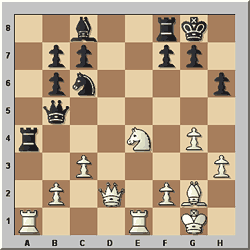
19.Nf6+. This spectacular move will only lead to a draw by perpetual.
The main alternative was 19.Rxa4 Qxa4 20.g5 , provoking the serious weakening
of Black's king's position without major material investments. For instance,
if 20...h5 then 21.Nf6+ when Black has to reject the present with 21...Kh8 ,
leaving White with a wide choice of maintaining his initiative. 19...gxf6
20.Rxa4 Qxa4 21.Qxh6 Qa5 22.Qxf6 Qc5 23.Be4 Ne7 24.Rd1 Ng6 25.Bxg6 fxg6 26.Qxg6+
Kh8 27.Qh6+ Kg8 1/2-1/2. [Click
to replay]
Carlsen,M (2690) - Morozevich,A (2741) [E66]
XXIV SuperGM Morelia/Linares MEX/ESP (1), 17.02.2007 [Mihail Marin]
1.d4 Nf6 2.c4 g6 3.g3 Bg7 4.Bg2 0-0 5.Nc3 d6 6.Nf3 c5. This move order
presents a series of minor advantages over the more popular 6...Nc6 7.0-0 a6
8.d5 Na5 9.Nd2 c5 10.Qc2 e5 . First of all, White's centre is submitted to less
pressure after 6...Nc6, offering White a wider choice of systems on the 8th
move. The second aspect will become clear later. 7.0-0 Nc6 8.d5. The
main drawback of this variation is that White can retain a tiny edge without
any risk by means of 8.dxc5 . However, the critical line against both 6...Nc6
and 6...c5 remains the advance of the d-pawn. 8...Na5 9.Nd2 e5 10.b3.
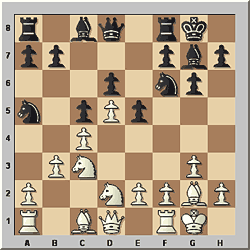
10...Ng4. This is Black's additional possibility compared to the 6...Nc6
lines. Black decides to start his kingside play without "wasting time"
with ...a6, ...Rb8 and ...b5. Leaving the a5-knight out of play for such a long
time is a very risky decision, but it seems to suit Morozevich' original and
enterprising style of play. 11.h3. Generally speaking, White should avoid
such weakening moves, unless he has something concrete in mind. A classical
brilliant game went 11.e4 f5 12.exf5 e4 13.f6 Nxf6 14.Ndxe4! Nxe4 15.Nxe4 Bxa1
16.Bg5 Bf6 17.Nxf6+ Rxf6 18.Qa1 Kf7
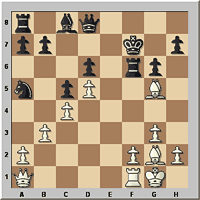
Analysis diagram
Now, after the quiet move 19.Re1!! Black found it difficult to defend against
the threats Rf3 or Qc3 b6 Re6! in Geller-Velimirovic, Havana 1971.
11...Nh6
12.Nde4. This novelty is a logical consequence of the previous move. With
the provocative knight jump to the centre, White aims to take advantage of Black's
temporary lack of coordination by energetical means.
12...f6.
Black intends to consolidate with ...Nf7. The generally desirable 12...f5
is met by 13.Ng5 , taking advantage of the weakness of the light squares in
Black's camp. 13.Nxd6!? There was no way back already. 13...Qxd6 14.Ne4
Qd8 15.Nxc5 White's compensation for the sacrificed piece is out of question.
The a5-knight did not improve its situation any bit, while the white central
pawns look threatening. 15...f5!? Morozevich chooses to return the material
"with interest", for the sake of rapidly completing his development.
15...Nf7? would have been bad because of 16.Ne6 Bxe6 17.dxe6 Nd6 18.e7 Qxe7
19.Qd5+ with a more advantageous position for White than in the game. However,
15...Nf5 or 15...Qc7 are worth investigating. 16.d6 e4 17.d7 Nf7 18.Rb1 Qe7
19.dxc8Q Raxc8 20.Na4 Rfd8 21.Qe1 Nc6.

Generally speaking, Black can be content with the outcome of the opening. He
is much better developed and has considerable advantage of space. Besides, the
g2-bishop will remain passive for a long time. However, White's position has
no weaknesses, which gives him hope to repell the first wave of Black's initiative
and retain the small material advantage. From this point of view, Carlsen's
play in the next phase of the game deserves the highest praise. 22.Nc3 Nd4
23.Bb2 b5 24.Nd5 Qd6 25.Bxd4 Bxd4 26.Rd1 Be5 27.Qa5 bxc4 28.Ne3 Qc7 29.Qxc7
Bxc7 30.Nxc4 Ne5 31.Rxd8+ Rxd8 32.Rc1 Nxc4 33.Rxc4.
Only a dozen of moves have passed since the previous diagrammed position and we
can see that White has fulfilled all the programmed tasks. He has provoked mass
exchanges and retained the extra-pawn at the same time. Even so, it is highly
questionable whether he has real winning chances, because of Black's persisting
advantage of space and the presence of the opposite coloured bishops.
33...Rd1+
34.Bf1 Bd6 35.e3 a5 36.Kg2 Kf7 37.Rc2 Ke7 38.Be2 Rd5 39.Bc4 Rd1 40.g4 f4? A
blunder just before the first time control. Morozevich must have overlooked White's
43rd move.
41.exf4 Bxf4 42.Re2 Rd4.
43.Bd3!! With this unexpected tactical resource, White wins a second pawn.
43...Kf6 [43...Rxd3 44.Rxe4+ leads to a hopeless rook ending.]
44.Bxe4
Rd2 45.Rxd2 Bxd2 46.Kg3 Be1 47.Kf3 Bb4 48.h4 h6 49.Ke2 Bd6. Morozevich' plan
is hard to understand. The best chance for survival was blocking the white pawns
on light squares with 49...g5 when White still needs to prove a winning plan.
50.Kd3 Bc5 51.f4 h5 52.g5+ Kg7 53.Kc4
This move marks the fiasco of Black's play in the endgame. Although he has managed
to block the enemy pawns on dark squares and make them vulnerable, the white king
has been given enough time to get activated. Black's counterplay will be too slow.
53...Bd6 54.Kb5 Bxf4 55.Kxa5 Bg3 56.Kb5 Bxh4 57.a4 Bxg5 58.a5 Kf6 59.a6 Be3
60.Kc6 g5 61.b4 Ke5 62.b5 Kxe4 63.b6 g4 64.a7 g3 65.a8Q Kf3 66.b7 Bf4 67.Qf8 Ke4
68.Qe8+ 1-0. [Click
to replay]
Schedule and results
Round 1: Saturday, February 17th |
| Vassily Ivanchuk |
½-½ |
Peter Leko |
Veselin Topalov |
½-½ |
Vishy Anand |
Peter Svidler |
½-½ |
Levon Aronian |
Magnus Carlsen |
1-0 |
Alex. Morozevich |
|
|
Round 2: Sunday, February 18th |
Peter Leko |
|
Alex. Morozevich |
Levon Aronian |
|
Magnus Carlsen |
Vishy Anand |
|
Peter Svidler |
Vassily Ivanchuk |
|
Veselin Topalov |
Games – Report |
|
Round 3: Monday, February 19th |
Veselin Topalov |
|
Peter Leko |
Peter Svidler |
|
Vassily Ivanchuk |
Magnus Carlsen |
|
Vishy Anand |
Alex. Morozevich |
|
Levon Aronian |
Games – Report |
|
|
Free day: Tuesday, February 20th |
|
Round 4: Wednesday, February 21st |
Peter Leko |
|
Levon Aronian |
Vishy Anand |
|
Alex. Morozevich |
Vassily Ivanchuk |
|
Magnus Carlsen |
Veselin Topalov |
|
Peter Svidler |
Games – Report |
|
Round 5: Thursday, February 22nd |
Peter Svidler |
|
Peter Leko |
Magnus Carlsen |
|
Veselin Topalov |
Alex. Morozevich |
|
Vassily Ivanchuk |
Levon Aronian |
|
Vishy Anand |
Games – Report |
|
|
Free day: Friday, February 23rd |
|
Round 6: Saturday, February 24th |
Magnus Carlsen |
|
Peter Leko |
Alex. Morozevich |
|
Peter Svidler |
Levon Aronian |
|
Veselin Topalov |
Vishy Anand |
|
Vassily Ivanchuk |
Games – Report |
|
Round 7: Sunday, February 25th |
| Peter Leko |
|
Vishy Anand |
Vassily Ivanchuk |
|
Levon Aronian |
Veselin Topalov |
|
Alex. Morozevich |
Peter Svidler |
|
Magnus Carlsen |
Games – Report |
|
|
Transfer to Linares, Spain |
|
Links
